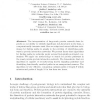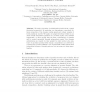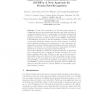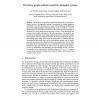93
Voted
RECOMB
2005
Springer
16 years 1 months ago
2005
Springer
Abstract. The interpretation of large-scale protein network data depends on our ability to identify significant sub-structures in the data, a computationally intensive task. Here w...
102
Voted
RECOMB
2005
Springer
16 years 1 months ago
2005
Springer
We present data-analytic and statistical tools for studying rates of rearrangement of whole genomes and to assess the stability of these methods with changes in the level of resol...
70
Voted
RECOMB
2005
Springer
16 years 1 months ago
2005
Springer
We study properties of multidomain proteins from a graph theoretical perspective. In particular, we demonstrate connections between properties of the domain overlap graph and certa...
98
Voted
RECOMB
2005
Springer
16 years 1 months ago
2005
Springer
137
click to vote
RECOMB
2005
Springer
16 years 1 months ago
2005
Springer
Abstract. Protein fold recognition is an important step towards understanding protein three-dimensional structures and their functions. A conditional graphical model, i.e. segmenta...
97
Voted
RECOMB
2005
Springer
16 years 1 months ago
2005
Springer
114
Voted
RECOMB
2005
Springer
16 years 1 months ago
2005
Springer
Abstract. With ever increasing amount of available data on protein-protein interaction (PPI) networks and research revealing that these networks evolve at a modular level, discover...
RECOMB
2005
Springer
16 years 1 months ago
2005
Springer
The multiple species de novo gene prediction problem can be stated as follows: given an alignment of genomic sequences from two or more organisms, predict the location and structur...
114
Voted
RECOMB
2005
Springer
16 years 1 months ago
2005
Springer
Abstract. We introduce an extended computational framework for studying biological systems. Our approach combines formalization of existing qualitative models that are in wide but ...
105
Voted
RECOMB
2005
Springer
16 years 1 months ago
2005
Springer
Abstract. Current approaches for identification and detection of transcription factor binding sites rely on an extensive set of known target genes. Here we describe a novel structu...




